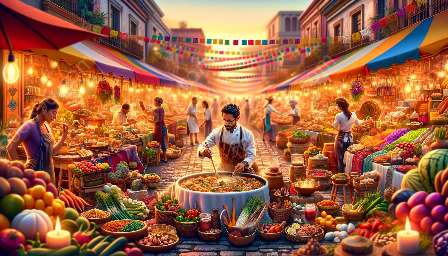Colombian cuisine is a delightful fusion of indigenous, African, Spanish, and Caribbean influences, resulting in a vibrant culinary tapestry that varies across different regions of the country. This topic cluster will dive into the delightful flavors, traditional dishes, and cultural significance of Colombian cuisine, while also exploring its regional variations.
History of Latin American Cuisine
The history of Latin American cuisine is a saga of cultural amalgamation and culinary evolution. From the ancient culinary practices of indigenous communities to the infusion of European, African, and Asian influences during the colonial era, Latin American cuisine has thrived on diversity and adaptability. The shifting tides of history have shaped the unique flavors and cooking techniques that characterize the rich tapestry of Latin American gastronomy.
Exploring Colombian Cuisine
The Cultural Blend
Colombian cuisine reflects the country's diverse cultural heritage, with each region contributing its own unique culinary traditions. The indigenous, African, Spanish, and Caribbean influences have melded together to create a flavorful and diverse culinary landscape.
Traditional Ingredients
One of the defining features of Colombian cuisine is its reliance on fresh and locally sourced ingredients. Staples such as corn, potatoes, yuca, plantains, and beans form the foundation of many traditional dishes. The array of fresh fruits, including lulo, guanabana, and mango, adds a refreshing and tropical twist to Colombian gastronomy.
Signature Dishes
Colombian cuisine boasts an array of mouthwatering signature dishes that vary from region to region. The hearty and iconic bandeja paisa hails from the Andean region, while the coastal areas are renowned for their exquisite seafood preparations such as fried fish and coconut rice. The Amazonian region showcases its unique culinary identity with dishes featuring exotic fruits, game meats, and river fish.
Regional Variations
Andean Region
The Andean region of Colombia is known for its diverse and hearty fare. Ajiaco, a flavorful soup made with chicken, corn, and potatoes, is a beloved specialty of the region. The mountainous terrain also results in a variety of potato-based dishes, such as papas chorreadas, where potatoes are smothered in a creamy cheese sauce.
Caribbean Coast
The vibrant and tropical Caribbean coast of Colombia introduces a medley of flavors, blending African, Spanish, and indigenous influences. Coastal cuisine features an abundance of fresh seafood, and dishes like arroz con coco (coconut rice) and patacones (fried plantains) are staples of the region's culinary repertoire.
Pacific Coast
The Pacific coast of Colombia offers a tantalizing fusion of African, indigenous, and Spanish culinary traditions. The region's cuisine highlights the abundant seafood, with dishes like encocado de pescado (fish in coconut sauce) and arroz con mariscos (seafood rice) enchanting the palates of locals and visitors alike.
Amazonian Region
The Amazonian region of Colombia boasts a rich culinary heritage, characterized by its use of exotic fruits, smoked meats, and freshwater fish. Dishes like maito de tilapia (tilapia wrapped in bijao leaves and grilled) showcase the inventive and sustainable cooking methods of the indigenous communities living in the Amazon rainforest.
Colombian Cuisine and Its Influence on Latin American Gastronomy
The diverse and vibrant landscape of Colombian cuisine has made a notable impact on the broader tapestry of Latin American gastronomy. Elements of Colombian cuisine, such as the use of tropical fruits, hearty stews, and unique preparation techniques, have influenced neighboring countries and contributed to the colorful mosaic of Latin American culinary traditions.
Conclusion
Colombian cuisine transcends geographical boundaries, serving as a testament to the rich tapestry of cultural influences that have shaped the country's gastronomic identity. From the bustling streets of Bogotá to the tranquil coastal towns, each region of Colombia offers a unique culinary experience, inviting travelers and food enthusiasts to savor the vibrant flavors and authentic preparations that define Colombian cuisine. By understanding the regional variations and cultural significance of Colombian cuisine, one embarks on a delightful journey through the heart and soul of Colombia's culinary heritage.

